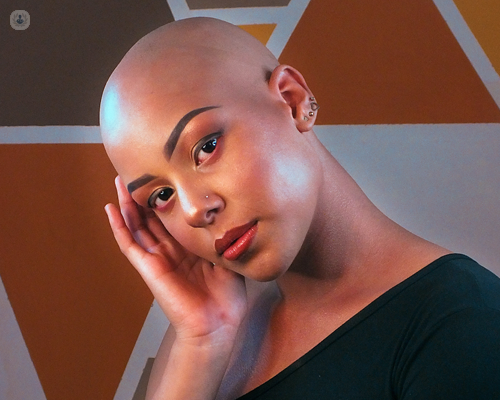Alopecia areata: What is it and how can it be treated?
Escrito por:When the immune system attacks hair follicles and causes hair loss, it is known as alopecia areata. It can be distressing for people who have it, and they may have questions about its nature and how it’s treated.
Here to assist is leading hair transplant specialist Dr Nilofer Farjo, who addresses exactly what alopecia areata is and what options there are to address it, in this informative piece.

What is alopecia areata?
Alopecia areata causes your hair to fall out in small sections, or patches. These patches are typically no more than several centimetres in length and can be almost unnoticeable. These patches can sometimes connect, however, and become more visible as a result.
First, you may notice clumps of hair on your pillow or in the shower. If the areas are on the back of your head, someone, like a friend, family member, work colleague or even your hairdresser/barber, may bring it to your attention.
It’s definitely worth noting that there are many other health conditions that can cause your hair to fall out in a similar pattern. Due to this, hair loss alone isn’t used to diagnose alopecia areata.
How does alopecia areata affect the body?
The condition develops when the hair follicles are attacked by the immune system. The follicles become smaller and stop producing hair as a result, leading to hair loss.
It can affect both men and women of any age. However, it begins in childhood in about 50 per cent of cases. Approximately one in 1,000 people, independent of ethnicity, have a form of alopecia areata. However, a family history and/or other autoimmune conditions are present in 10 to 25 per cent of people presenting with alopecia areata.
Onset of alopecia areata can dramatically vary. It’s a condition that will develop slowly over time for some, and will recur after years between instances. However, sudden hair loss may occur on the scalp for others. In some cases, it may also affect the eyebrows, eyelashes and beard, as well as other parts of the body.
What are extreme cases of alopecia areata like?
Extreme cases can result in total loss of hair on the scalp, known as alopecia totalis, or hair loss across the entire scalp (including eyebrows and eyelashes) and the rest of the body (including pubic hair), which is called alopecia universalis.
For some people, their hair back will grow back but it may also be the case that their hair falls out again. It depends on the individual regarding the extent of hair loss and regrowth. The exact way in which this happens isn’t yet understood.
Is there a cure for alopecia areata?
There is no known cure for alopecia areata at the moment. There are treatments, however, that can help hair grow back more quickly in some instances, as well as prevent future hair loss.
How is alopecia areata treated?
Several products and different techniques which can be used to help cover up hair loss are available, as well as resources to help cope with the stress related to it.
Medical treatments for alopecia areata can include the use of:
- Topical agents, such as Minoxidil
- Steroid injections – A common option for mild, patchy alopecia to assist regrowth on bald spots
- Oral treatments, for example cortisone tablets, which are sometimes used for extensive alopecia.
Light therapy for alopecia areata, also known as photochemotherapy or phototherapy, is another option. This is a type of radiation treatment which utilises a combination of an oral medication called psoralens and UV light.
Many people will choose natural treatments or alternative therapies for alopecia areata, alongside medical treatments, such as:
- Aromatherapy
- Acupuncture
- Microneedling
- Low-level laser therapy (LLLT)
- Vitamin supplements such as zinc or biotin.
- Essential oils like tea tree, rosemary and lavender, as well as peppermint.
If you’d like to talk to Dr Farjo about your hair loss, don’t hesitate to book a consultation via her Top Doctors profile.



